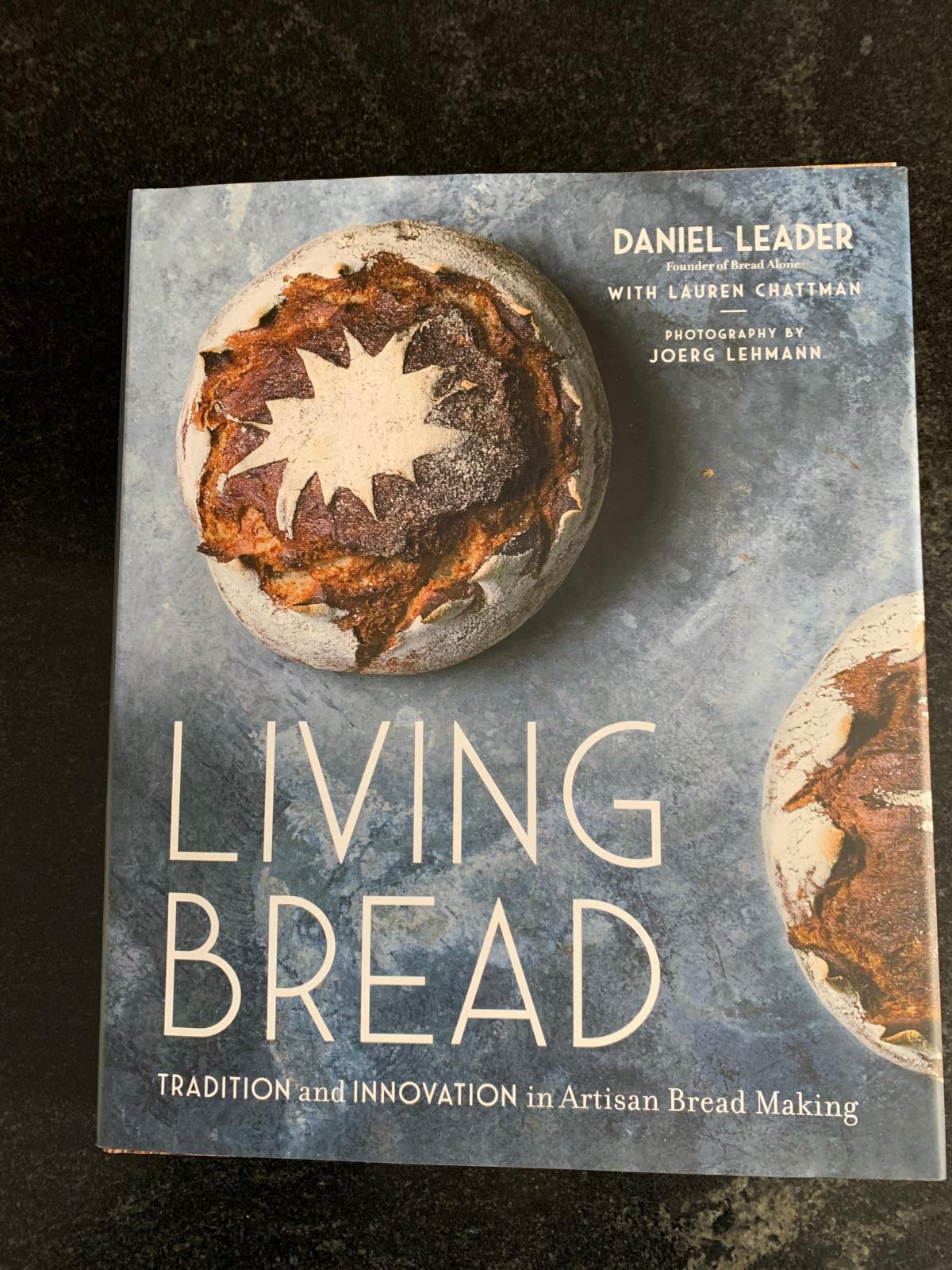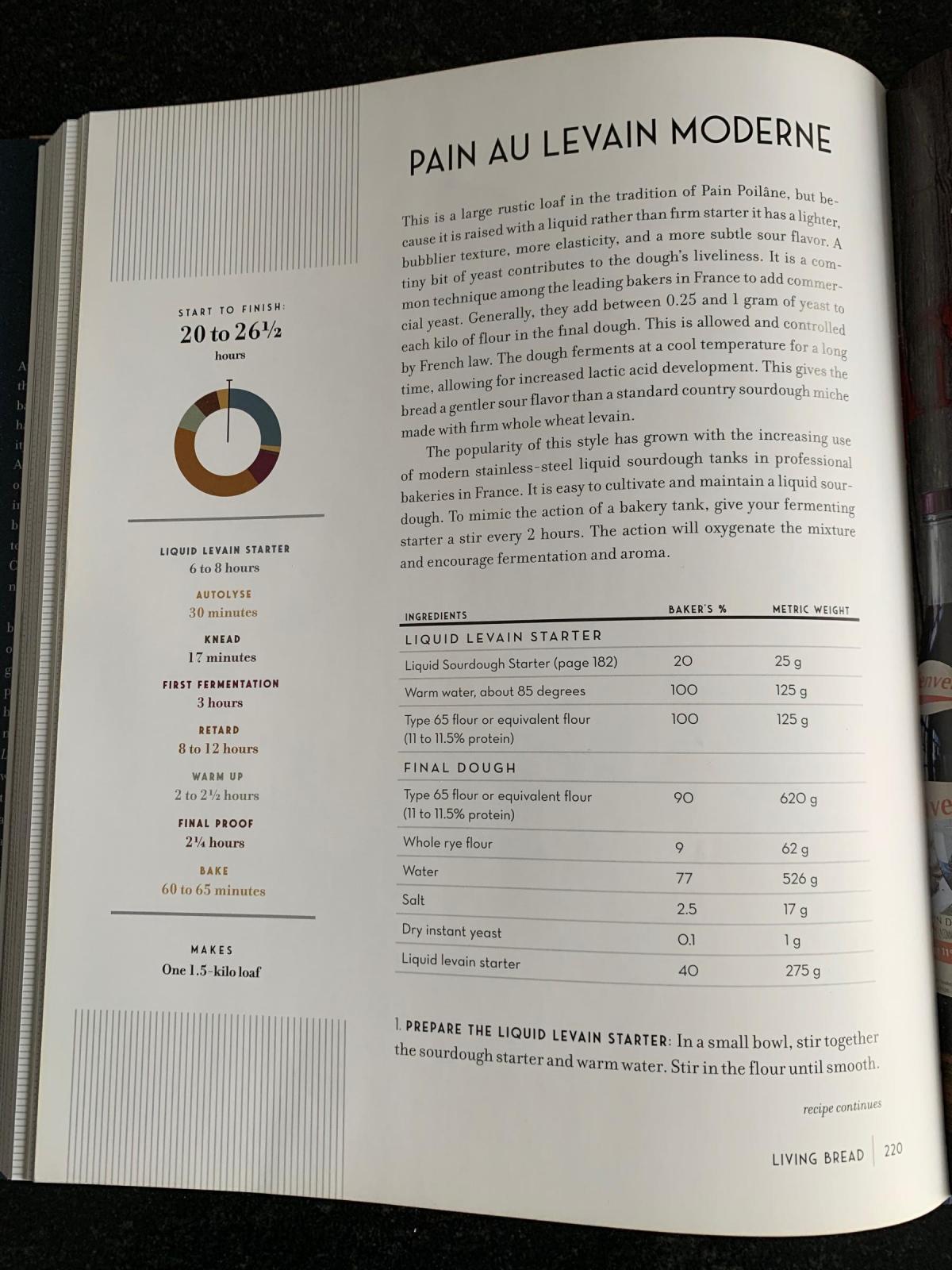
Daniel Leader's Living Bread

I received a copy of Daniel Leader's Living Bread for Christmas this year. While it contains 50-plus formulae for breads, Leader seems more focused on the stories of the grains, the growers, the millers, and the bakers he encountered in Europe. That's all good and makes for an engaging read, since he is obviously passionate about his subjects. I would, however, strongly recommend you obtain a copy from your local library to read before deciding whether to purchase the book.
My impression, having read the entire book and baked one of the breads, is that this is a book that I will not bake from frequently. Much of that comes down to the ingredients in the breads. While it is becoming easier to source European flours here in the U.S., there are some very specific flours that Leader highlights which will be very expensive for North American bakers. (Note that Leader does provide sources for these flours in the last chapter of the book.)
The book is organized as follows:
- Introduction
- Changing Wheat Landscapes
- Understanding Artisanal Flour
- Essential Baking Practices
- Straight Doughs
- Yeasted Pre-Ferments
- Simple Sourdoughs
- Complex Sourdoughs
- Sprouted Breads
- Using Leftover Starter
- Bread Connects Us
- Resources: Ingredients and Equipment
- Resources: Bakers and Mills
- Acknowledgements
- Index
Leader does a decent job of describing how various grains have emerged, been abandoned, and are enjoying a resurgence as growers and millers rediscover the qualities they possess. Milling techniques, particularly stone grinding and roller milling, are discussed. He also spends some time talking about how flours are characterized in different countries and the different bases for grading flours. All of this is good to know, both as general background information and as specific-to-a-formula information.
When he gets to the bread formulae, Leader does a couple of things that I really appreciate. First, all ingredients are shown with their Baker's % and their metric weight. That's all. No avoirdupois weights, no volumes. Right off the bat, that eliminates a lot of possibility for the errors that plagued his Local Breads book. The second thing Leader provides with each formula is a dial and table that list the estimated times for each stage of the bread. An example is shown below on the left side of the page:

I think this is a praise-worthy inclusion since it provides the baker with an at-a-glance understanding of the probable timetable for making the bread.
One debatable feature of the formulae is that any levains, pre-ferments, or soakers are listed in the final dough section as ingredients, with a corresponding baker's %. If you want to understand the amount of pre-fermented flour in the final dough, or the overall hydration of the final dough, you'll have to do that math for yourself.
A number of the formulae end with a "Note for Professional Bakers" that gives them a heads-up for anything in the formula that Leader believes could be a concern in a production environment. Those are helpful for the home baker, too, though the smaller batches we make are less likely to encounter the issues that might occur in larger batches.
I haven't examined the formulae closely enough to see whether errata will be a problem. There appear to be some copy-paste chunks of text that could lead to some of the problems that were seen in Local Breads. For example, the formula pictured above talks about shaping the bread into a boule and baking it in a Dutch oven, using wording that is nearly identical in other formulae. However, the photograph that accompanies the formula shows a batard shape. Go figure. Directions for steaming the breads that are baked on a stone always mention putting ice cubes in a preheated cast-iron skillet. That isn't necessarily a problem but there are more effective methods for steaming a home oven. While I think that the editing and proof-reading for this book may be better than for prior books, it will be interesting to see what emerges as more people bake from the book.
Bottom line: I'm happy to have the book although, as I said earlier, I doubt that I will bake from it very often. There are a handful of breads that I want to try and it is possible that some of them might enter the regular baking rotation. I appreciate Leader bringing my attention to some of the European flours, millers, and bakers that I hadn't know of previously. He obviously cares a great deal about bread and the people who make it, and that shines through the text.


I also own this book and, like Paul, I haven't baked from it very frequently. I am not really concerned about obscure flours - if you want to bake niche Italian breads authentically, for example, then you might need to source some hard to find flours or at least work out how to substitute them when possible.
I am more concerned that a lot of the recipes, including the sourdough ones, seem to include a hefty dose of IDY, possibly as an insurance policy for beginner bakers. I did query this with Mr. Leader, but have not got an explanation yet.
Nevertheless, thank you for your review Paul - you have reminded to pick up the book again and give it another chance!
deleted
I'm almost a year late to this thread, but I also received it for Christmas last year. I have been baking from it frequently and have some favorites that are now in my regular rotation. The criticisms are valid - this is NOT for the inexperienced baker. Many details are left out. Also, I don't use a KA mixer (I have an Ankarsrum) so the times for mixing are not of use to me. I do wish he spoke more to the level of development instead of how long in the KA. I can figure it out for myself by looking at the different times for proofs, etc., but sometimes I have to test first and make my own adjustments.
As for the flours, many of the Italian flours can be found on Amazon. With a little research, you can get the W levels of Caputo flours, which are easy to obtain. Here is one source: https://thepizzaheaven.com/caputo-00-flour/
I do encourage you to give some of the recipes a try. Some of my favorites are the Seele, Domberger Rye, Pane di Altamura, and I love the Pain au Sarrasin. I bake it without the triangle banneton, but have one on order since I make it so frequently. The quinoa twist is also nice. I like that these formulas are unique and something I don't see in bakeries or in most books.
I also love the stories - I like to know the background of the bakers and how Leader enjoyed the breads, but I am also someone who loves travelogues vs. travel guides. If I can read a cookbook like a regular book, I'm pretty happy - even if I don't use it much. But this one has been my go-to all year, has challenged my skills and taught me some new things as I experiment.
As a bonus, there are a few unique discard recipes as I loathe to throw away my starter. Everyone else has the same ol' waffles, pancakes, croutons, choc. chip cookies, etc. I wish all sourdough books had some unique twists on discard. It's a constant dilemma!